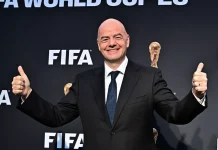The 2025 FIFA Club World Cup ended in July with highest revenues ever and highest prize pool ever to be seen in club football with exceptional records. However, as FIFA basked in a two billion dollar business bonanza and a spectacular demonstration of its status as a global brand, the World Cup revealed plenty of festering disagreement concerning the capitalization of soccer and the fate of genuine fan loyalty. It featured 32 of the world-best clubs, representing six continents, and playing in 12 cities of the U.S., which made the event ambitious, admittedly at the expense of tradition, identity, and consumer interest.
Financial Success Anchored in Global Commercial Strategy
A historic prize pool and who benefited
The disintegration of the economics of international club football by FIFA in distributing a billion dollar pricing pool of which $475 million was allocated to sporting performance and $525 million to participation receptarized the economics of international club football. Chelsea topped the list after collecting $115 million after being crowned and Paris Saint-Germain won the second place with $107 million earned. Even clubs which failed in the group stage were given more than 10 million dollars each, and this is much more than in a range of annual budgets of leagues in Africa or Asia.
The money is not only an indicator of performance but strategic participation rewards, which will prompt the clubs of the six confederations to invest and bring their strongest teams. Real Madrid, Palmeiras, and Al Ahly were among the other major earners, with each gaining tens of millions from group and knockout appearances.
Broadcasting rights and marketing deals fuel the engine
The financial core of the tournament came from broadcasting rights, with global viewership monetized via deals with DAZN, TNT Sports, and regional partners. DAZN’s global rights deal was valued at over $1 billion, giving FIFA its single most lucrative digital agreement to date.
Sponsorship deals, hospitality packages, and high-end matchday experiences in host cities like Los Angeles and New York also generated significant returns. FIFA projects $13 billion in revenue for the 2023–2026 cycle, with the Club World Cup contributing over 15%.
A Tournament with Uneven Reception Across the United States
Disparity between stadium attendance and viewership
Despite the financial triumph, matchday attendance painted a more complex picture. Average attendance for group stage matches hovered around 34,700, but many games, particularly between non-European teams, drew fewer than 10,000 fans in massive stadiums built for NFL games.
Games featuring European powerhouses—such as Chelsea vs. River Plate in Miami or PSG vs. Al Ahly in Dallas—drew crowds above 70,000. But the contrast with sparsely attended matches like Auckland City vs. Wydad Casablanca in Phoenix was stark.
This patchiness revealed the limitations of hosting such a dense tournament in a nation still developing a soccer culture. Geography played a role too: long distances between venues reduced traveling fan groups and disrupted continuity in fan energy.
Broadcast success and digital engagement
TV and streaming audiences offered a more encouraging signal. TNT Sports in the U.S. averaged over 418,000 viewers per match, with marquee fixtures peaking at over 950,000. Globally, DAZN reported a 21% increase in user traffic during the tournament compared to UEFA Champions League broadcasts.
This divergence—strong virtual engagement but lackluster in-person turnout—raises long-term questions about FIFA’s strategy. As digital viewership grows, FIFA may prioritize virtual fan experiences, augmented reality, and global reach over live atmosphere. But the soul of the game still resides in the stadium.
FIFA’s Dual Role as Governing Body and Global Brand
Commercial imperatives driving tournament expansion
The 2025 edition marked a transformation of the Club World Cup from a low-profile seven-team contest into a 32-team juggernaut. For FIFA, this was about equity and opportunity, but also about competing with UEFA’s Champions League for global dominance.
Gianni Infantino promoted the event as a unification exercise in football, but opponents say it was also a business venture that lacked much in terms of sporting value. Some clubs even used the group stage as a pre-season workout and shifted squads around and focused on domestic league duties.
Players were strained by the congested calendar which already sees several players play in over 60 matches annually. Players unions expressed danger of fatigue and injuries, especially since the tournament will be held in July after continental tournaments, such as Copa America and UEFA Euro 2024.
FIFA’s image and future governance challenges
This development subjects FIFA firstly as a sports organization, and secondarily as a commercial juggernaut. Its ruling today is determining revenue streams of leading clubs and television networks, occasionally to the exclusion of player safety and viability of accessibility to spectators.
The danger is perceived: when the fans and smaller associations think of FIFA not as a promoter of the game, but as a money-making company, the legitimacy dies. Open governance and investment on grassroots systems is no longer ethical but a strategic requirement.
Disparities and Opportunities in Global Football Ecosystems
Redistributing wealth and competitive access
An essential advancement was the creation of the solidarity fund of 250 million relating to the clubs that did not take part and federations as well as the grass-root projects. Although this is considered as symbolic money, this pool is minute when compared to the profits made by the top eight participating clubs.
Nevertheless, to smaller teams such as Auckland City and Esperance Sportive de Tunis, the price of admission was revolutionary money at 12-15 million dollars entry costs. There are national associations that already promised to spend such money on the retrofitting of stadiums and youth programs.
But this brings in a question; will club world cups regularly occurring even increase the gap between international and local teams? Or will the tournament ever be used to fill the gap with the help of infrastructure development, talent pipeline, and common exposure?
Regional representation and structural imbalances
A huge 64 percent of the overall prize was won by European clubs, which further asserted the power of UEFA. Teams in South America performed better than in the past years but teams in Africa and Asia were overwhelmed even with expenditure and talented players.
The arguments of analysts were that in terms of seeding in the tournament, it was the proven markets and the tight schedule shouldered logistical demands on the clubs that had the low travel spending and supporting cast.
This individual has already discussed the subject matter in a Sky Sports interview where he pointed out that in as much as the monetary triumphs of FIFA are spectacular; the company should be concerned with fan interaction and game fairness which will lead to sustainable development. The analyst stated that one should synchronize commercial success with the enthusiasm which makes soccer the global phenomenon.
🚨 FIFA president Gianni Infantino:
“The FIFA CWC has been a huge huge huge success.”
“We generated almost $2bn. It’s already the most valuable cup competition in the world. Chelsea vs PSG is a fantastic final.” #CFC 🏆🌎 pic.twitter.com/3kKPg7B0TQ
— Chelsea Dodgers (@TheBlueDodger) July 12, 2025
A Defining Moment in the Commercialization of Global Football
The FIFA Club World Cup of 2025 highlights a critical change in the nature of monetization, presentation, and consumption of soccer. It was a soaring commercial success-setting new records in the areas of viewership, sponsorship, and money-payout. However, its deficiencies, particularly when it comes to live involvement and parity, present the picture of a sport that is in transition.
FIFA now has a two-fold problem: to make sure that the revenues that allow to develop football across the globe remain in the organization, as well as to save the community-oriented spirit of the game. Getting that delicate balance right will mean that future Club World Cups raise the game, rather than water it down into a global media commodity which has lost all its sense of passion.
What unfolds in the next tournament cycle may redefine football’s trajectory—either toward deeper connection or greater commodification. Fans, clubs, and federations are watching closely, not just for goals, but for meaning.













